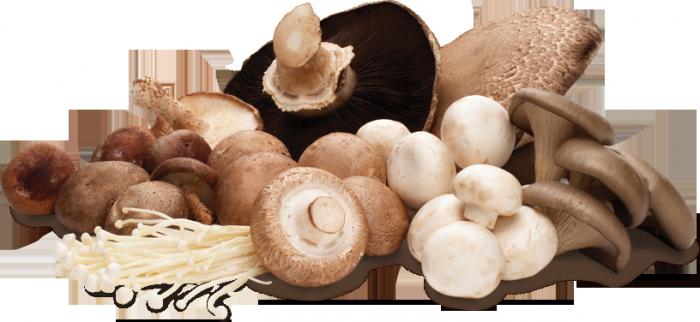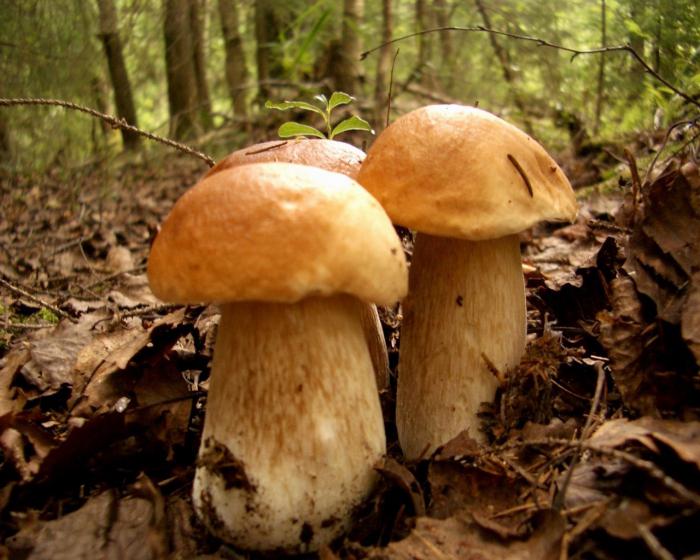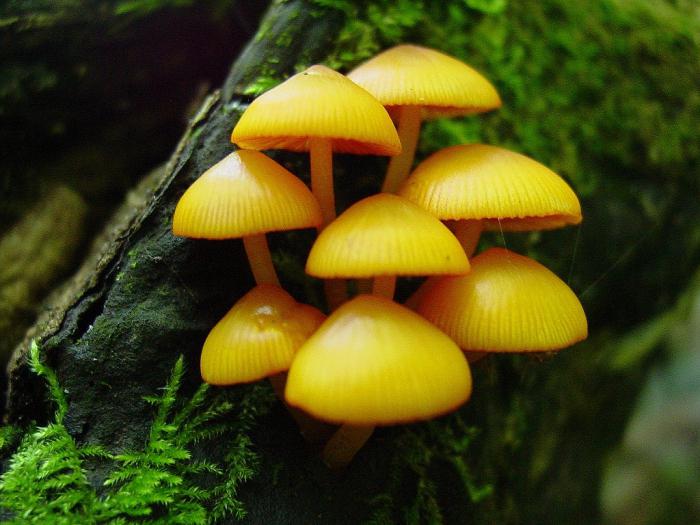Public lesson
Class Basidiomycetes.
Features of structure and life activity.
Goals: continue acquaintance with the diversity of living organisms, introduce them to the structural features and reproduction of cap mushrooms, teach them to recognize edible ones from inedible ones, introduce them to a mushroom picker’s guide to study local mushrooms.
Lesson type: combined.
Laboratory work:"The structure of cap mushrooms."
Equipment: fresh mushrooms, dummies, table, pictures, book, magazine, magnifying glass.
^ Methods: conversation, teacher's story, notebook work, laboratory work, student messages.
During the classes
Ι Repetition of the material covered - biological dictation.
1) Science that studies mushrooms? (mycology)
2) According to the method of nutrition, mushrooms (heterotrophs)
3) Where spores are formed in ascomycetes (in the bag)
4) Which representative of zygomycetes did we study (mukor)
5) Do chytrids have mycelium? (No)
6) The vital close relationship between organisms is called (symbiosis)
7) The mycelium, merging with the root of the tree, forms? (mycorrhiza)
ΙΙ Learning new material.
1) What is this class of Basidiomycetes?
1) Student message: Basidiomycetes unite 30 thousand species with multicellular mycelium and special sporulation organs - basidia (outgrowths). Representatives of this class are widely known - cap mushrooms - they got their name from the structure, the stem is covered with a cap. They can be either annual, growing from 10 to 14 days in one season, or perennial woody growing on trees, stumps, and roots. Cap mushrooms are divided into 2 groups: lamellar - champignons, milk mushrooms, oyster mushrooms, russula, etc. and tubular - boletus, boletus, aspen, White mushroom and others.
Teacher: Today we will look at the structure of the fruiting body of an agaric mushroom. Let's do it laboratory work task 1. Examine and sketch the fruiting body of the mushroom and label it.
What parts of the fruiting body have you labeled? (leg and cap).
Second task, use a magnifying glass to look at what the stump is made of? (from hyphae - dense cells). What does the cap consist of (chitinous skin with pigments and hyphae ending plates). What kind of records are these? (these are branches of hyphae with spores).
2) How does sporulation occur?
2) Student message: The fruiting body of the mushroom has binuclear hyphal cells; during the formation of spores, two nuclei merge and two divisions occur, 4 spores are formed. When they germinate, they produce mononuclear hyphae of the mycelium, which grow, branch and fuse with the hyphae of another spore or their own; upon fusion, a binuclear cell is formed, which will give rise to the fruiting body of the fungus.
So how do mushrooms reproduce?
What types of mushrooms are there?
3) What edibles do you know?
(student message)
4) What nutrients do mushrooms contain?
(student message)
5) What poisonous mushrooms You know
(student message)
Working in a notebook
5) What edible mushrooms grow in our area? What do you know about them?
(student message)
Our boys went to the forest to pick mushrooms.
The structure of mushrooms varies depending on their species. Majority edible mushrooms consists of a stem and a cap, which is where their name comes from - cap mushrooms. Their spore-bearing layer is located at the bottom of the cap.
Cap mushrooms are divided into lamellar And tubular depending on how their spore-bearing layer is built.
Mushrooms in which spores are located inside a special organ - Asuka, or bags, are called marsupials. These include . There are mushrooms that have spores inside the mushroom itself. These include all types of raincoats and truffles, (more details:)
Classification of cap mushrooms by category
Many literary sources give classification of cap mushrooms by category. At the same time, nutritional value and taste are taken into account. There are four such categories. The most valuable mushrooms are classified as first category. Despite some differences in the definition of categories of certain types of mushrooms among different authors, they are all unanimous in defining the most valuable mushrooms of our forests: saffron milk mushrooms, boletus and white (true) milk mushrooms, (more details: , ). It is these three species that are classified as first category mushrooms in any guide.

Co. second category all authors include: boletus, boletus, oak. And then there are discrepancies. Some people think boletus, morels, honey mushrooms and chanterelles mushrooms of the second category, others - third; in some determinants yellow milk mushroom belongs to the first category, in others to the second, etc. It should be noted that each mushroom has its own individual aroma and taste unique to it. And since there is no comrade for taste and color, then a novice mushroom picker should not neglect mushrooms of the third and fourth categories. Perhaps among them there will be a mushroom that he will like more than the venerable authors of identifiers.
Community of mushrooms and trees
Many mushrooms have a clear preference for certain types trees. And some of the names of the mushrooms themselves speak about this: boletus, boletus, oak, poplar row, aspen mushroom... It has been established that the mycelium of mushrooms adjacent to trees intertwines with their roots, forming mycorrhiza - mushroom root b. This partnership is beneficial to both: the mushroom receives carbohydrates from the tree and, in turn, supplies it with water and nutrients. minerals, which it “makes” from decomposing plant residues.
Where do cap mushrooms grow?
Most species are edible cap mushrooms growing in sparse forest, preferring shady places. In dense, difficult forests they are very rare. Mushrooms also do not like thick grass and dark, wet lowlands. More attractive to them hillocks and sides of forest roads. If the soil is excessively saturated with moisture, the mushrooms “rise” to the tops of the slopes; if there is little rainfall, they “hug” against the tree trunks.
Mushrooms are 90 percent water, so as long as the soil lacks moisture, they cannot grow. Normal development mycelium occurs at a temperature of 15–25° C. Under unfavorable climatic conditions the mycelium stops its growth and seems to freeze. It can remain in this state for decades. The mycelium is extremely tenacious. She is not afraid of severe frosts, excessive heat, or drought. Mushrooms grow in the hot steppes of Central Asia.
In Yakutia, along the banks of the Lena, moss mushrooms, boletus mushrooms, boletus mushrooms and boletus mushrooms grow. Even in Spitsbergen they collect morels, russula, boletus and moss mushrooms. Paradoxically, the mycelium is destroyed by water, without which it cannot develop. The fact is that for the existence of mycelium and spores, they need an influx fresh air. If the mycelium is under water, it will soon die.

The Age of Edibles cap mushroom very short. Typically formed underground, the size of a match head, a fungus favorable conditions appears on the surface after three to four hours. It is still very tiny, but the next morning it reaches the required size and can be cut. Full ripening of cap mushrooms occurs in five to six days. Age limit the vast majority of edible mushrooms are 10–11 days.
A very convenient feature of the growth of mushrooms is that they originate in the same mycelium different time. This allows the mushroom picker to pick mushrooms in the same place the next day. An experienced mushroom picker will not look for buttercups in an aspen forest or, say, a chanterelle in a dry meadow or a saffron milk cap in poplars. A novice mushroom picker will be interested to know which trees they prefer to grow under.
- – pine, birch, oak;
- Blue boletus - oak;
- Valuy – pine, birch;
- Girodon – pine, birch, aspen;
- Govorushka – smoky pine;
- – pine, birch, oak;
- – pine, birch, aspen;
- – poplar;
- Raincoat, (more details:) – pine, birch, oak, aspen, poplar;
- – oak;
- Hare mushroom, (more details:) – pine, oak;
- - pine;
- – pine, birch, oak, aspen;
- – pine, birch, oak, aspen;
- – birch, oak;
- - birch;
- – pine, oak;
- – birch, aspen;
- – pine, birch, oak;
- – oak, acacia, poplar;
How diverse is the world of mushrooms, these creatures of nature, endowed with some properties of both plants and animals! Not so long ago, in 1970, scientists identified them as a special kingdom (at first, many mushrooms were classified as plants). And the science that describes life various types mushrooms, began to be called mycology (section of botany).
Great Kingdom
You already know that these are not only white mushrooms, boletus mushrooms, boletus mushrooms, honey mushrooms and other cap mushrooms that we encounter in the forest, collecting them for cooking. And not just those champignons and oyster mushrooms that litter supermarket shelves. The kingdom of mushrooms is the largest group of organisms living on planet Earth: from the simplest threads invisible to the naked eye to giant boletus mushrooms that can give shelter, like in a fairy tale, to small animals and insects. And cap mushrooms are only a small, but undoubtedly important, segment of this large community. This is what we will talk about today. 
General characteristics
These include, first of all, the well-known forest mushrooms: porcini and aspen mushrooms, boletus mushrooms and milk mushrooms, russula and fly agarics, honey mushrooms and champignons and many others. They grow in forests - deciduous and coniferous, in swamps, meadows, near water. And in the city they can be found in parks, squares, and gardens. It is about them that some fairy tales of the peoples of the world are written, it is they who are mostly consumed as food, since many of these creatures of nature are edible and useful for humans.
Mushrooms and people
Cap mushrooms play a very important role in people's lives. important role. First of all, especially in ancient times, it is one of the sources of food. Mushrooms contain a lot of protein, microelements and vitamins, which allows them to occupy a worthy place in the human food chain even today. Cap mushrooms can be prepared in a variety of culinary ways. And with their participation in world kitchen practice, various peoples of the Earth have hundreds of delicious dishes.

Symbiosis
Cap mushrooms are also of great importance for higher plants. Most of them are saprotrophs and live only in association with trees (by the way, this is reflected in some names: boletus, boletus, for example). How do cap mushrooms eat? The mycelium tightly wraps around the root sponges, performing a unique function of root hairs, contributing to fully supply and saturation of the barrel nutrients, minerals and water. And from trees, cap mushrooms receive ready-made organic matter, which is processed into inorganic compounds that act as food for higher plants. Thus, a symbiosis of these several species manifests itself, a mutually beneficial cooperation, called mycorrhiza.
Fruiting body
Actually, what we are used to calling a mushroom is only integral part the whole organism, its fruiting body. The other (and main) part - the mycelium - is hidden from prying eyes in soil rich in humus or in rotten wood. In most species it consists of numerous hyphae. It is from these that, under favorable circumstances (rain, warm weather), the fruiting bodies of cap mushrooms are formed and crawl to the surface. Usually they consist of a cap and a stem (but there are also mono-variants: only the cap).
Tubular and plate
You probably already know what kind of cap mushrooms are found in nature? They are divided into tubular and lamellar. In the first, spores intended for reproduction are capable of forming in narrow tubules of the cap, which have a tubular shape. In the second, the spores are located in the plates of the cap.
Lamellar
Their caps are quite fleshy, sometimes elastic, leathery and membranous. The most famous: russula, volushki, milk mushrooms, champignons, honey mushrooms, and many other types of cap mushrooms. There are about 300 species of russula alone! Many of them are edible and are traditionally consumed by humans in salted, boiled, and fried form. Some have a rather pungent aftertaste that disappears when soaked and boiled. Honey mushrooms have become especially popular; there are also many types of them, most of which are edible. Champignons, also classified as agaric mushrooms, often grow in nature on soil and manure, in meadows and pastures. They often form circular settlements, which are popularly called “witch rings.”

Tubular
There are just under 250 species of them in nature. They are found everywhere in temperate latitudes of various countries on the planet. They have a cushion-shaped cap, round in shape and fleshy. The tubular layer of the cap is quite easy to peel off. It is known that many tubulars enter into symbiosis with higher plants- trees certain type. Almost all tubular ones are edible. The most famous are: white boletus, boletus, boletus, moss mushroom, boletus. Some of the tubular ones also contain antibiotics that can kill pathogens.
Artificial cultivation
In terms of cultivation and artificial cultivation of mushrooms: for many tubular mushrooms this seems unlikely. Since they exist only in symbiosis with certain trees. Thus, to breed, for example, boletus on an industrial scale, you will need to plant an entire birch grove. But the cultivation of some lamellar plants is not only possible, but has also been successfully used by people for several centuries. Thus, the experience of people breeding champignons goes back up to 300 years. And the now popular oyster mushroom is grown in damp basements with great success.
Poisonous cap mushrooms
Poisonous cap mushrooms, which can cause severe poisoning, pose a particular danger to people. Of these, it is considered the most poisonous. If eaten (even after boiling it first), it can lead to death.

Fly agarics, gall and also pose a danger to humans. Under no circumstances should they be eaten. As a rule, these mushrooms also have edible counterparts that are similar in appearance. This further increases the danger of mushroom picking. And before you go mushroom hunting, you need to clearly learn to understand the types of mushrooms so as not to become a victim food poisoning. And some caps are conditionally edible. These include: pigs, morels and stitches. They are removed by repeated boiling and changing the water. Beginner mushroom pickers should also remember that some mushrooms, even those considered edible, can turn out to be poisonous if collected along railway or highway. This happens because mushrooms tend to absorb harmful substances, emitted by locomotives and cars. So, when going for mushrooms, it would be best to go deeper into the forest.

The materials from this article can be used to conduct a biology lesson on the topic “Hat mushrooms” (grade 5).
